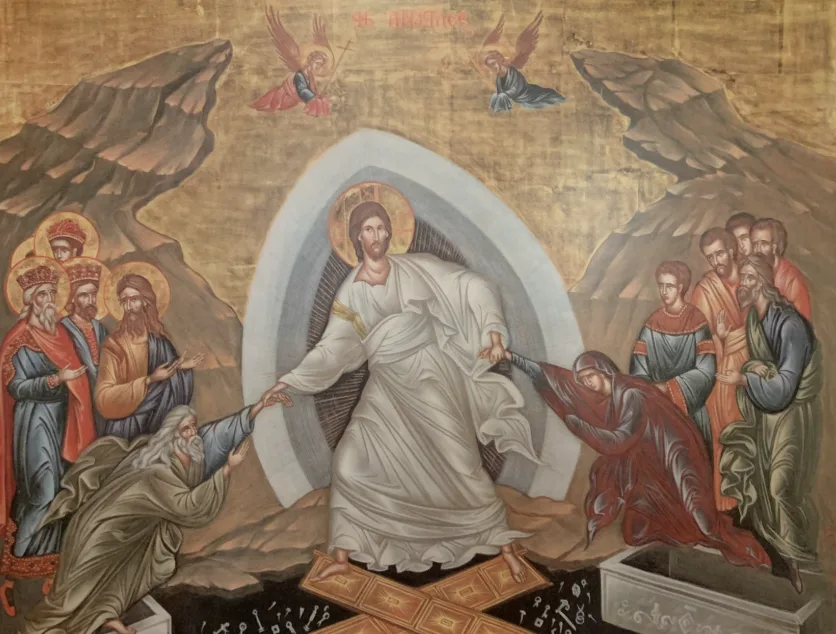
The Vespers with the Divine Liturgy of St. Basil the Great on Holy Saturday is one of the most important liturgical services in the Eastern Orthodox Church and Ukrainian Greek Catholic Church (UGCC). It combines two distinct parts: the Vespers (evening prayer) and the Divine Liturgy of St. Basil the Great, and it marks a key transition from the sorrow of Holy Friday to the joy of Holy Saturday and the Resurrection. This service is profound, solemn, and filled with anticipation of the coming feast of Pascha (Easter).
On Holy Saturday, the Church commemorates the harrowing of Hades—Christ’s descent into the realm of the dead to conquer death and free the righteous souls awaiting salvation.
The Divine Liturgy of St. Basil the Great is celebrated because of its ancient Paschal connection. Traditionally, this liturgy is considered more solemn and theologically rich than the regular Divine Liturgy, with longer prayers, hymns, and antiphons that reflect the mystery of Christ’s Passion and Death and anticipate His glorious Resurrection.
On Holy Saturday, the Church is in a state of waiting: Christ’s body lies in the tomb, but His victory over deathis about to be revealed. The Liturgy of St. Basil beautifully expresses this waiting, using the long prayer of the Eucharistic Canon and the prayers for the dead.
This service is a moment of deep mourning as the Church remembers the death of Christ but also a moment of intense expectation for the Resurrection, which will be celebrated in the coming hours at the Paschal Vigil.
St. Basil the Great’s Liturgy is considered more theologically elaborate than the Liturgy of St. John Chrysostom (which is used for most other Sundays). It has a more extended Eucharistic prayer, which focuses on the depth of Christ’s incarnation, death, and Resurrection.
The special prayers and hymns reflect the high solemnity of Holy Saturday, a day that stands between the despair of Christ’s death and the hope of His Resurrection. The Liturgy is thus part of the Church’s entry into the Paschal Mystery, as the faithful prepare for Christ’s victory over death.
The blessing of Easter foods after the Vespers with the Divine Liturgy of St. Basil the Great is a cherished custom in many Eastern Christian traditions, particularly among the Slavs and Ukrainians. This practice ties into both spiritual and cultural aspects of Holy Saturday and Pascha celebrations.
The food blessing occurs after the Divine Liturgy because the Paschal Vigil begins immediately after this service. The blessing of foods marks the culmination of the Great Fast (Lent), as believers, who have been fasting for 40 days, now prepare to celebrate the Resurrection with joy and feasting.
The food is blessed as a symbol of thanksgiving and blessing from God for the bounty of creation, which Christ has redeemed through His Death and Resurrection.
This blessing is connected to the idea of renewal: just as Christ brought life through His Resurrection, the blessed foods represent the new life the faithful are about to share.
Traditional Easter foods in the Ukrainian and Eastern Christian tradition include:
Paska (Easter bread), symbolizing the Body of Christ.
Khrin (horseradish), representing the bitterness of Christ’s suffering.
Eggs, symbolizing new life and the Resurrection of Christ.
Cheese, ham, and meats, representing the feast after the fast and the joy of the Resurrection.
These foods, which were forbidden during Lent, are now blessed and consumed in celebration, highlighting the Church’s victory over death and sin.
In Ukrainian and Slavic cultures, the blessing of foods often takes place after the Divine Liturgy on Holy Saturday (or early Sunday morning, after the Paschal Vigil), in a deeply communal and family-centered atmosphere.
Families bring baskets of these foods to church for the blessing, often accompanied by candles and other symbols of the joyful anticipation of Pascha.
The blessed foods are then taken home, and after the midnight Paschal service, they are enjoyed in celebration and fellowship.
Holy Saturday marks the transition from the fasting of Lent to the feasting of Pascha, and the blessing of food symbolizes that transition. The prayers and blessing tie together both the spiritual journey of Lent and the joyful anticipation of Christ’s Resurrection.
The food blessing is not just about eating—it’s about the faithful entering into the Paschal joy, receiving God’s blessing on their lives and their renewed relationship with creation.
This act of blessing and then eating the foods, particularly after the Liturgy of St. Basil, mirrors the Eucharistic meal: just as the bread and wine are transformed into the Body and Blood of Christ, the food at home is spiritually transformed by the blessing and becomes a sign of the Resurrection.
Easter food blessings underscore the idea that everything, even earthly food, is made holy and is transformed through Christ’s Resurrection.
The Vespers with the Divine Liturgy of St. Basil the Great on Holy Saturday is a rich liturgical moment that brings the Church from mourning Christ’s death to awaiting the joy of His Resurrection. It is through this service that the faithful enter into the mystery of Christ’s descent into Hades and His triumph over death, while the blessing of Easter foods provides a tangible and communal celebration of the new life in Christ that follows the Resurrection.
The foods blessed on this day represent not only the end of the fast but also the beginning of a new spiritual reality, where death and sin have been overcome, and life and joy are restored to creation. The entire service and its practices point to the great Paschal victory and the hope of eternal life.